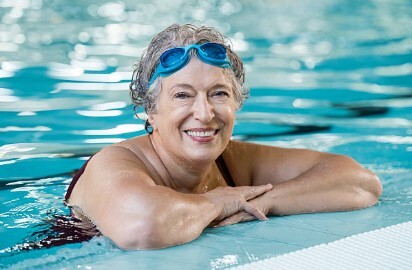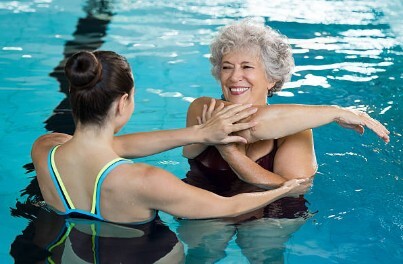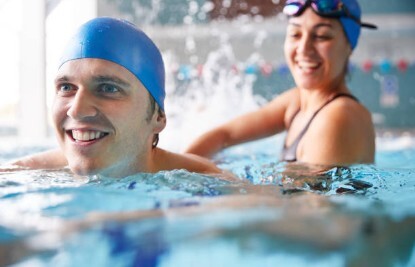Let’s face it: if you’re an adult facing your first ever swimming lesson, you’ve probably got some anxiety about what you’re getting yourself into.
Don’t.
You are going to be more than fine. I am a huge fan and advocate of private adult swim lessons. For grown-ups with fears of water, or adults who simply never learned how to swim, there is never a better time to learn than now. Believe me when I say any adult can learn how to swim. With a dedicated private instructor, adults with no prior experience can be swimming laps in a matter of weeks. It is truly worth the time and investment.
Now that all sounds nice and motivating, but I’ve worked with adults who dreaded the thought of swim instruction right up through the first lesson. The uncertainty, the concern, maybe the embarrassment, can all combine to make facing a swim lesson a taxing endeavor. To help with that, this article will give you a brief overview of what your first week of swim lessons might look like. One less thing to wonder and worry about.
This typical example schedule is what you would generally expect if you were joining me for a private swimming lesson as an adult who has never learned to swim and has some degree of fear or discomfort with water. The week would consist of five 30-minute lessons, Monday – Friday. However, you can always have less swim lessons per week if you prefer. Let’s jump in!
Example Adult Swimming Class Schedule:
Day 1:
The first day, you and I would sit down next to the pool (maybe with our feet in the water) and have a chat. This would include some introductions where I’d ask you to tell me about yourself. I’d want to know things like.
- Your swimming background, if any.
- Why you wanted to take swim lessons.
- What is your goal? What do you hope to be able to do by the end of our time together?
- Fears about water or any past bad experiences with water.
- Any health issues or injuries I should be aware of.
And so on. I’d also tell you about my experience swimming and teaching in the water. The point of all this is twofold: First, I want to develop a tailored lesson plan specific to your goals and needs. Second, I want you to be able to trust me and trust yourself.
I’d then introduce you to the pool from the outside. First, we could walk around the perimeter and I would show you the various depth markers, ladders, stair cases, lifeguard chair, etc.
Now I know what you’re thinking: by the end of this, we’re probably already 20 minutes into our 30 minute lesson and we haven’t even gotten into the water yet! Yup. And that’s ok. There will be plenty of time for that.
For our last 10 minutes, we’d get in the pool. And here’s the big reveal: Your initial beginner swimming lessons are never going to take place in water deeper than your hips. After I told you that, I would walk with you over to the staircase or ladder nearest the shallow end. We’d then practice using the ladder or stairs to enter the pool into a standing position. And then we would just walk. We would literally take those remaining 10 minutes to simply walk around the shallow end in water that only comes up to your waist. Depending on your level of comfort, I would be there to support you, hold an arm, etc. We’d also take a walk holding onto the wall or edge of the pool. This is an important step because it starts to familiarize you with the feel of the water, the resistance, the natural buoyancy of your body. It’s a baby step that we will build on in future lessons.
And that’s it! Day one complete. Give yourself a pat on the back and realize that in many respects, the hardest part is behind you.
Day 2:
On the second day, we’d pick up right where we left off. We’d use a ladder or stair to ease into waist-deep water and start walking again. Once you feel comfortable with that, we start getting fancy. For example, I’d have you hold onto my arm and then I’d ask you to put one foot out in front of the other, bend slightly at the knees, and then touch your chin to the water. We’d continue to build on that. I’d ask you to do the same thing and blow bubbles. I’d ask you to then plug your nose with your other hand and try putting your face in the water with your eyes closed or with goggles on. Once you could put your face in the water, I’d then have you start holding it there a second or two at a time. This would require you to hold your breath. Then we’ll start increasing the time by a second. Then another. Then another. By the end of this exercise, chances are you’d be able to hold your breath and keep your face in the water for five to ten seconds while standing.
Once you accomplish that, we’d then start practicing some variations. We’d try it without you holding on to me. We have you remove your hand from your nose and try to push air through it while submerging your face. And based on how it's going and how you're feeling, we would just practice, practice, practice these skills. The 30 minutes of day 2 will go fast.
Day 3:
Once again, we’d pick up right where we left off (you’re probably detecting a pattern here...) We’ll start by having you stand in waist deep water and practice holding your breath with your face submerged. Once that’s out of the way, I’ll start to explain the concept of floats: what they are, how they work, and how to do them. The rest of day three will entail practicing floats with me supporting and assisting you. You’ll be able to start experimenting with your balance in the water, the different feelings of semi-weightlessness, and how your body moves differently. I’ll be within arm’s reach the entire time, probably holding you up or supporting your body so that you can get the proper feel of floating. I’ll also have you practice those movements and motions with your hand on the wall or edge of the pool. During all this, the comfort for you is knowing that at any point during these floats, you can just stand up if you need to. We’ll have practiced it enough at this point that righting yourself and standing up in the water will be second nature. Reflexive. Again, those 30 minutes will go fast, but that is probably all we’ll be working on during the third lesson.
Day 4:
Starting where we left off (again), we’ll go back to walking in the water, putting faces in the water, and practicing some assisted floats with either the wall or with me holding onto you. The importance of being able to float comfortably cannot be overstated. We’ll discuss how they apply to survival swimming, how long you could float if you needed to, etc. And we’ll practice them. Over and over and over again. The goal of today is to finish the lesson with you being able to float independently on your stomach and back for ten seconds or more. If that sounds like a tall order, trust me: you’ll be there or very close to it by now. Once you’ve got some comfort in floating, it will be time to start introducing some new fun movements that turn floating into swimming.
Day 5:
In simple math terms, floats + kicks + arm movements = swimming. And by day five, you’ll likely already have mastered the hardest of those three components. So then I would introduce you to the other two. I’d explain the basics of kicks and give you a few exercises to try, like holding onto the wall while kicking, hugging a kickboard and trying those motions on your back. We’d probably spend some time out of the pool on the deck trying the same motions you’ll use in the water. I’d also introduce the arm motions. We’d walk around the pool scooping big armfuls of water, we’d try doing it with our face in the water or while holding on to the wall, etc. We’d have fun with it. And before you knew it, day 5 would be done.
And so would your first week of lessons!
Conclusion:
The cool thing is that every lesson after that week will build on the same skills you learned the week before. Week 2 of lessons will pick up where lesson 5 left off and we’d do lots of practice with floats, arms, and legs. By the end of the week, you’d be putting those three components together and learning how to breathe while moving in the water. And with all the skills you’d have by the end of Week 2, it’s just a matter of practicing before you're swimming front crawl across the pool and treading water effortlessly.
On average, most adults can learn to swim in around three weeks. Some go faster, some take a little more time. But every adult I’ve worked with got there eventually. So if you’re feeling apprehensive about your upcoming lessons, don’t! Hopefully this article has given you some idea that your first lessons will be simple, safe, and successful. See you at the pool!
At Sunsational Swim School, our professional swimming instructors travel to your home or community pool. Learn more about our adult swimming lessons and get started on basic swimming and stroke technique today!
ABOUT SUNSATIONAL SWIM SCHOOL
Sunsational Swim School is the 🥇 #1 rated provider of private, at-home swimming lessons in America. We have specialized swim instructors for students ages 6 months to adult, beginner to advanced. Featured on ABC, CBS, Impact 100, The List and others, Sunsational instructors have a minimum of 2 years of teaching experience, are CPR certified and insured, and have collectively taught over 302,223 lessons for more than 74,415 students nationwide!






